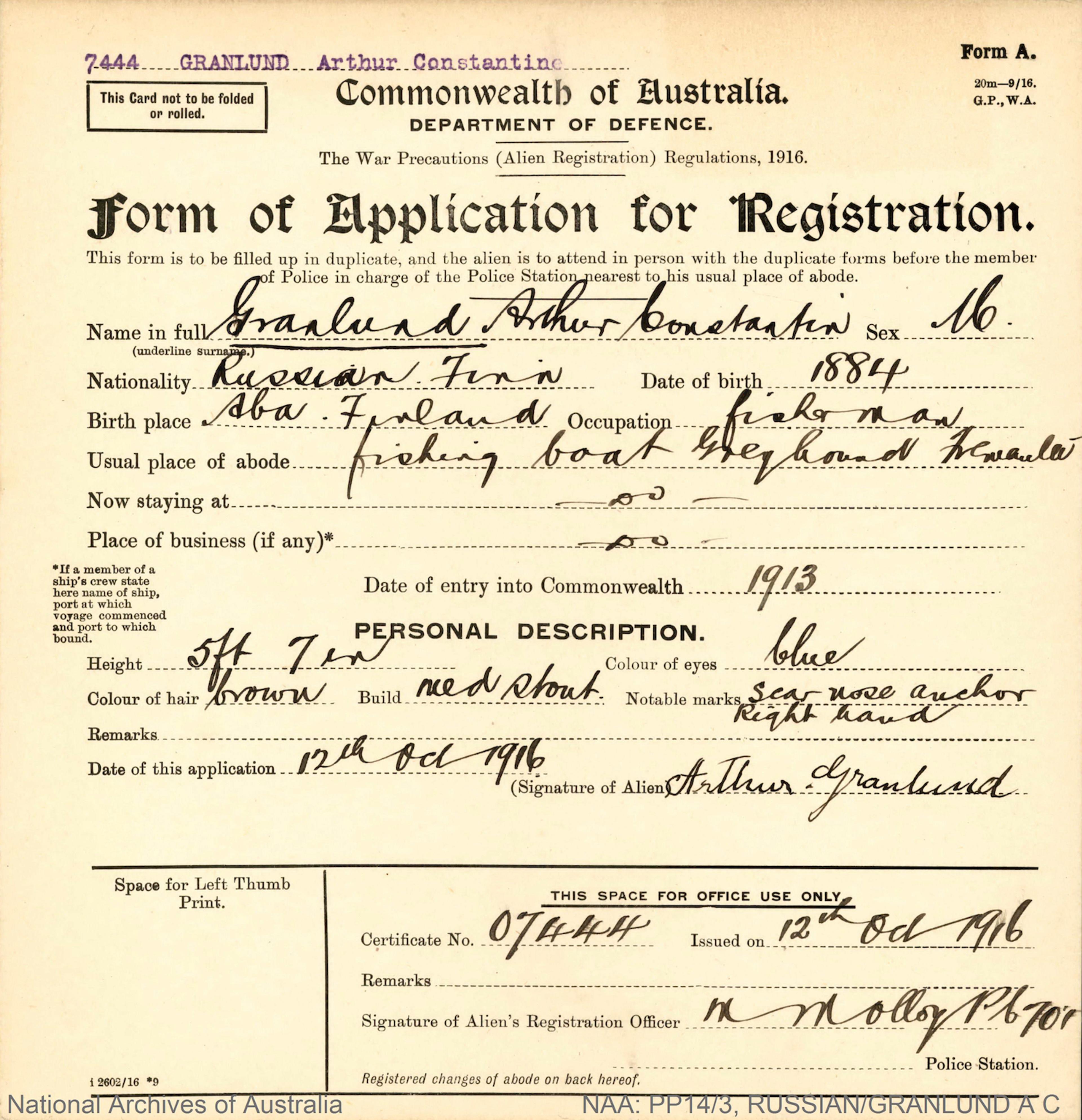Ollie
Vessel Name: Ollie
Arthur Granlund
Edward Charles Ryles
Lost at Sea; Bodies recovered and buried
End of September 1922

Arthur Granlund Alien Registration Papers
On 18 September 1922, the Fremantle fishers, Arthur Granlund and Edward Charles Ryles, left Fremantle in the schooner Ollie for a fishing expedition. After a month, the boat and men failed to return and a search party went looking for the them.
Granlund, a 35 year old Finn, lived alone aboard Ollie, suggesting a solitary lifestyle that was common among some of the Scandinavian fishers on the Mid-West Coast, who had jumped ship to live a solitary life fishing in Western Australia.
Ryles, however, resided in Essex Street, Fremantle, and had relatives living in the wheatbelt district of Wyalkatchem. He was 26 years of age.
Water policeman, Constable Howard, and Fisheries Department inspector, James Brown, searched unsuccessfully the northern part of Jurien Bay in a launch on 21 October 1922. After searching the mainland and islands in that area of the coast they returned to Fremantle on 30 October.
This search by Fisheries and Police attracted the interest of other fishers in the area.
Two Italian fishers noticed wreckage of a boat near Lancelin and recognised the debris as being the Ollie. The mast had been broken off and the deck smashed, and the two men concluded the small vessel operating in a treacherous part of the coast, had overturned.
They unsuccessfully looked for the missing fishers, Granlund and Ryles.
However, on returning to the same area on 31 October 1922, Raffael and his mate from the boat the Silvery Wave found Granlund and Ryles’ remains, two and half kilometres (one and half miles) apart on a beach about half a metre (two feet) above high water mark.
Raffael and his off-sider speculated that the bodies must have been trapped under a reef before being washed ashore after their first visit.
The Italian men buried the two deceased men and marked their shallow grave with crosses.
Early Saturday morning 4 November, a fisher ‘Raffail’ [sic] and his mate, reported to the Fremantle Police Station that they had located wreckage of the Ollie and the bodies of the two missing men on a beach near Lancelin Island.
After receiving this report in Fremantle, Inspector Brown and Constables Howard and Hetherington left late on Saturday to retrieved the decomposed bodies and bring them back to Fremantle.
Dr E Williams inspected the bodies at Fremantle and advised the bodies of the two men indicated no suspicious wounds, and he concluded that they had both drowned before being washed ashore about the end of September somewhere in the vicinity of Lancelin Island.
The Sunday Times, citing Raffael as the source, reported that “the men must have been alive when washed ashore, owing to the distance from the shore where the bodies were found; also that Ryles, from the appearance, and position of his legs, must have been attacked by cramp,” contradicts Raffael’s report of the bodies being half a metre (two feet) above high water mark. Hardly sufficient distance to suggest the men had been alive when washed ashore, let alone evidence Ryles had cramp, and such speculation was not entered into the coroner’s report.
L Bolton, Acting Coroner, opened the inquiry into the deaths of Arthur Grandland and Edward Charles Ryles, fishers of Fremantle. In summation, he concluded that the men left Fremantle on a fishing expedition on 18 September 1922, and when they had not returned some weeks later, searches were made and the bodies of the two men were found on a beach near Lancelin Island.
Dr E Williams’ evidenced suggested the men drowned while swimming, and the two men and the wreckage of the Ollie were eventually washed ashore and discovered by two fishers and recovered by Inspector Brown and Constable Hetherington.
The Acting Coroner concluded the two men had met their death by drowning about the end of September somewhere in the vicinity of Lancelin Island.
